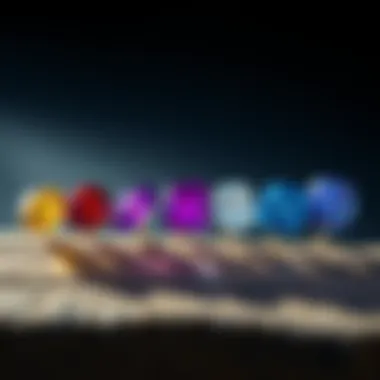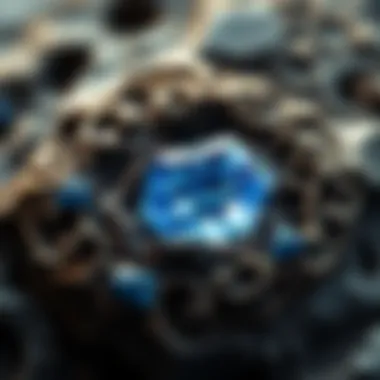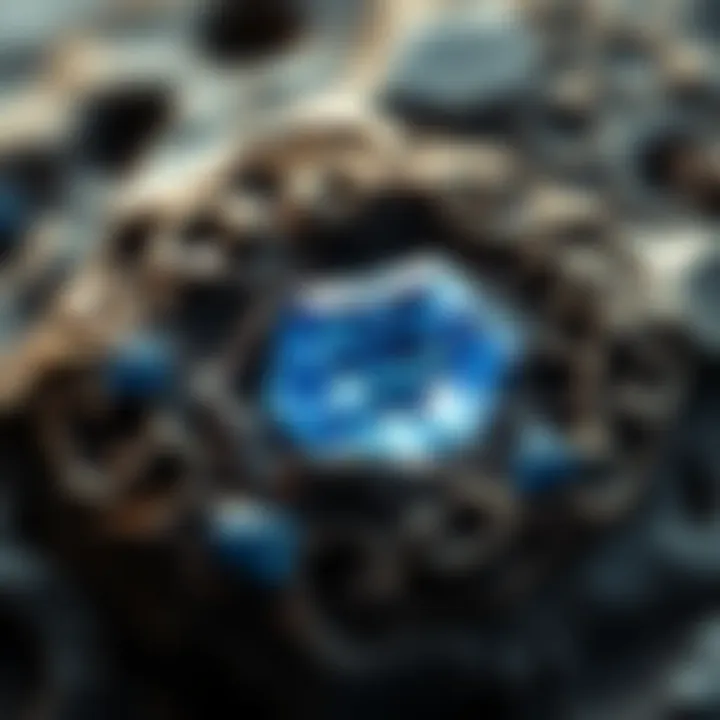Understanding Sapphire Hardness: A Comprehensive Exploration


Intro
When one thinks of gemstones, there's an almost universal acknowledgment that not all gems are cut from the same cloth. Sapphire, in particular, stands out—not just for its deep, mesmerizing color palette but also its impressive hardness. Gemstone hardness is a critical aspect that often dictates not only the gem's aesthetic appeal but also its practicality in everyday life.
This article aims to take a close look at sapphire's hardness, elbowing its way through the more intricate aspects of this fascinating gemstone. By examining the Mohs scale of hardness and uncovering how various factors influence sapphire's resilience, we hope to illuminate an often-overlooked dimension of this precious stone. So strap in as we explore the remarkable intersection of beauty and strength that sapphire embodies.
Overview of Gemstones and Minerals
History of Gemstone and Mineral Use
The journey of gemstones dates back to prehistoric times. Evidence shows that ancient civilizations valued gem stones not only for their beauty but also for their supposed magical properties. From Egyptians adorning sarcophagi with lapis lazuli to ancient Greeks believing in the protective powers of amulets, gemstones have been weaved into the tapestry of human culture for millennia.
As centuries turned, these precious stones weren’t just prettified baubles; they became tokens of power, spirituality, or love. The crown jewels of various monarchies, for example, showcased dazzling gemstones to project authority and grandeur.
"Gemstones are not just for adornment but serve deeper significances throughout history and culture."
Significance in Culture and Society
Gemstones have a way of entwining themselves into the rituals and beliefs of different cultures. From birthstones to wedding rings, they carry meanings that can span generations. In many societies, sapphires symbolize nobility, truth, and sincerity. Their role in culture is undeniable, impacting art, literature, and even philosophy.
Gemstone Formation and Properties
Formation Process of Gemstones
Understanding sapphires requires diving into their formation process. Sapphires primarily consist of corundum—a crystalline form of aluminum oxide. They typically form deep within the Earth’s crust under extreme heat and pressure. This lengthy process involves various minerals that create the blue or other colored hues we admire today. It’s like a slow-brewed tea, where the perfect balance of conditions leads to extraordinary results.
Properties that Define Gemstones
Several properties classify gemstones and distinguish them from one another. Hardness, clarity, and luminosity are paramount. Sapphires score a solid 9 on the Mohs hardness scale, which places them just below diamonds, making them some of the toughest gemstones available. This resistance to scratching and wear lends sapphires their endless charm in the jewelry market.
Classification based on Color, Hardness, and Luster
Sapphires come in a range of colors—blue, pink, yellow, and more—each presenting different facets of beauty. The clarity and luster can dramatically influence their market value and desirability. A well-cuts sapphire showcases its brilliance, much like an artist presenting a meticulously polished piece of work.
In summary, the fascinating world of sapphires is not solely about their visual allure. Understanding their formation, properties, and classification dovetails beautifully with the concept of hardness, exposing layers of relevance that extend beyond surface aesthetics.
Foreword to Sapphire Hardness
When we delve into the intricate world of gemstones, sapphire stands out not only for its stunning hues and charm but significantly for its remarkable hardness. Understanding sapphire hardness is critical for various reasons, particularly for those who cherish these gemstones as collectors, jewelry designers, or enthusiasts. This section aims to illuminate the importance of hardness in sapphires and set the stage for a more in-depth exploration of the topic.
Hardness in gemstones refers to how resistant a stone is to scratching and other forms of wear. For collectors, knowing a gemstone's hardness is paramount; it influences the gem's longevity and practicality in everyday wear. A higher hardness means a greater ability to withstand daily mishaps, making sapphires a wise choice for rings or wristwatches, where durability is key.
Benefits of Understanding Sapphire Hardness
Having a firm grasp on sapphire hardness also opens numerous doors for gemstone enthusiasts. Here are some points worth noting -
- Investment Value: Gemstones like sapphires, known for their exceptional hardness, retain their value and beauty through the years.
- Maintenance Requirements: Knowing how hard a stone is can inform collectors about suitable cleaning methods and care routines.
- Greater Appreciation: Understanding the science behind hardness enhances appreciation for the craftsmanship involved in cutting and setting sapphires.
The journey into sapphire hardness not only enriches one’s knowledge but also engenders a deeper connection to this precious gem. In the following sections, we will embark on an exploration of sapphire's position on the Mohs scale, its physical and chemical properties, and how all these aspects work together to form the fascinating characteristics of sapphire.
Defining Hardness in Gemstones
Hardness can be defined scientifically as the measure of a material's resistance to deformation, typically by means of scratching. In the context of gemstones, it is most commonly assessed using the Mohs scale, which ranks minerals on their scratch resistance from 1 (the softest, talc) to 10 (the hardest, diamond).
Gemstones are more than mere decorations; they hold varying degrees of hardness that dictate their everyday utility. For example, softer stones like opals and pearls are quite susceptible to scuffs and scratches, which could detract from their natural beauty. In contrast, sapphires, with a hardness rating of 9 on the Mohs scale, stand resilient against such wear.
In essence, defining hardness hinges on understanding its measurement, the implications that follow, and how this knowledge fundamentally affects decisions made by collectors, jewelers, and designers.
Why Hardness Matters for Gemstone Collectors
For gemstone collectors, hardness is a touchstone factor in evaluating quality and desirability. A gemstone's hardness goes beyond mere numbers; it directly influences the wearability and practicality of a piece.
- Longevity: Harder gemstones, such as sapphires, tend to last longer and keep their appearance intact, allowing collectors to enjoy their investments over time without worrying about wear and tear.
- Resale Value: The resale market favors gems showcasing high hardness levels, as these typically exhibit less damage from previous ownership.
- Design Versatility: Hardness directly affects how a gem can be fashioned and mounted in jewelry. Sapphires can be cut into intricate designs that would risk the integrity of softer stones.
Moreover, understanding hardness can also signal treatments a gemstone has undergone. Some sapphires are heat-treated to enhance their color and clarity, which can impact their hardness as well. This knowledge arms collectors with the insights needed to make informed decisions. By prioritizing hardness, gemstone collectors can ensure that their selections align with their goals, whether those are for personal enjoyment or investment.
The Mohs Scale of Hardness
The Mohs scale of hardness is a pivotal framework in the world of gemstones. It provides a straightforward method to assess a mineral's resistance to scratching. The scale runs from one to ten, offering a way to evaluate the durability and practical applications of gemstones and other materials. Pioneered by mineralogist Friedrich Mohs in 1812, this system not only serves as a tool for gem enthusiasts but also for professionals in various fields, including geology and materials science.


Understanding where sapphire falls on this scale offers insights into its worth and resilience, influencing everything from jewelry design to its industrial uses.
Overview of the Mohs Scale
At its core, the Mohs scale categorizes minerals based on their ability to scratch one another, where talc sits at the bottom with a rating of one, and diamond, the hardest of all materials, sits at the top with a rating of ten. Each mineral can scratch those below it, providing a simple hierarchy. The scale includes familiar materials such as quartz (rated 7) and fluorite (rated 4), making it relatable for anyone interested in gemstones or simply curious.
Here's a brief overview of the scale:
- 1: Talc
- 2: Gypsum
- 3: Calcite
- 4: Fluorite
- 5: Apatite
- 6: Orthoclase Feldspar
- 7: Quartz
- 8: Topaz
- 9: Corundum
- 10: Diamond
The scale is not linear but relative, meaning that the jump from one number to the next is not uniform in terms of hardness, which is an essential facet to grasp.
Sapphire's Position on the Mohs Scale
Sapphire is categorized as a corundum, which gives it a hardness rating of nine on the Mohs scale. This position places it just beneath diamond, highlighting its strength and durability. Such a rating indicates that sapphire can withstand wear and tear superbly well, making it an excellent choice for various applications from rings to wristwatches.
Its impressive hardness is also a significant reason why many jewelers favor sapphire for engagement rings and other fine jewelry. In everyday wear, sapphire does not scratch easily and retains its allure for years, a factor that most collectors and buyers consider vital.
"With a hardness of 9, sapphires stand as champions of gem durability, capable of enduring life's little scratches and a bit more."
Comparison with Other Gemstones
In comparing sapphire to other gemstones, its hardness prominently positions it alongside other well-regarded stones like ruby, which is also a form of corundum. However, when we consider other gemstones like emerald (hardness of 7.5 to 8), or opal (around 5.5 to 6.5), the difference in durability is stark. The ability of sapphire to resist scratches not only enhances its aesthetic appeal but also solidifies its practicality in various settings.
To put things into perspective, here’s a quick comparison:
- Sapphire (Hardness: 9): Highly resistant to scratching, suitable for everyday jewelry.
- Emerald (Hardness: 7.5 - 8): More susceptible to scratches, requires careful handling.
- Opal (Hardness: 5.5 - 6.5): Delicate, less ideal for rings used daily.
Thus, sapphires hold a strong advantage over these softer stones, ensuring their place in both high-end jewelry and industrial applications. Overall, knowing where sapphire stands on the Mohs scale enhances the appreciation for its beauty and resilience, making it a favorite among collectors and enthusiasts alike.
Physical and Chemical Properties of Sapphire
Understanding the physical and chemical properties of sapphire is pivotal in grasping not only its beauty but also its formidable strength. These properties dictate how sapphire interacts with various forces and how it is perceived in both natural and synthetic settings. The more informed one is about these characteristics, the better they can appreciate sapphire’s multifaceted role in jewelry design, industrial applications, and gemstone collecting.
Composition of Sapphire
Sapphire is primarily composed of aluminum oxide (Al2O3). This simple yet robust chemical formula underpins its properties. While one might think that a straightforward composition translates to uniformity, the beauty of sapphire lies in its ability to come in a variety of colors—except red, which we classify as ruby. The presence of trace elements like iron, titanium, and chromium can lead to this stunning array of hues.
- Iron and titanium can create the classic blue sapphire through a process of color diffusion while also influencing the stone's opacity and visibility in lower light.
- Chromium, on the other hand, adds a rich pinkish tint, leading toward the alluring pink sapphire variant.
The purity of the sapphire's composition also greatly influences its clarity and hardness. Higher concentrations of impurities can result in a less vibrant color and potential clouds within the stone, which in turn affects its overall value.
Crystal Structure and Its Impact on Hardness
Sapphire crystallizes in the corundum family, known for its trigonal crystal system. This unique arrangement contributes significantly to its hardness rating of 9 on the Mohs scale, making sapphire one of the hardest natural gemstones out there. The tight packing of aluminum and oxygen atoms forms strong ionic bonds that resist corrosion and wear.
In terms of structural features, the local arrangements of atoms in sapphire lead to a level of durability that few other gemstones can contend with. As the old saying goes, “hard as a rock,” but with sapphires, it takes on a whole new meaning. Their exceptional resistance to scratching is a key reason they are favored in high-end watches and rings.
“The strength of a sapphire lies not just in its beauty but in the very foundation of its atomic structure.”
These structural characteristics play a crucial role in how sapphires withstand everyday wear. However, even the hardiest of gems require TLC to maintain their gleam. The unique crystal lattice can also absorb impurities, potentially impacting the clarity and vibrational properties of the gemstone. So, understanding this aspect isn't just a lesson in chemistry but also vital for anyone considering sapphire for jewelry or industrial purposes.
Exploring these physical and chemical properties not only deepens one’s appreciation for sapphires but also equips consumers with knowledge that proves beneficial when purchasing or caring for these timeless gemstones. For further reading, you can check Britannica for insights into the science behind sapphires or visit Wikipedia for a broader overview on the topic.
Formation of Sapphires
The formation of sapphires is a critical aspect of understanding the hardness and characteristics of this remarkable gemstone. Grasping the nuances of how sapphires are formed—whether through natural geological processes or through human intervention—adds depth to collectors' knowledge and appreciation. The nuances of sapphire formation have implications for their quality, value, and even their aesthetic appeal. By delving into the origins of sapphire, we uncover not just a gem's beauty but also its journey through time and earth.
Natural Processes Leading to Sapphire Formation


Sapphires form under specific conditions deep within the earth’s crust. This gem primarily consists of corundum, which is aluminum oxide. What makes sapphires unique are the trace amounts of other elements, such as iron, titanium, or chromium, that lend sapphires their diverse color spectrum. Natural sapphire formation involves a combination of high temperatures and pressures, often occurring in metamorphic rocks or volcanic environments.
Here are key points about natural sapphire formation:
- Geological Environment: Most sapphires form in regions where metamorphic rocks have undergone extreme heat and pressure. Areas like Madagascar and Sri Lanka are renowned for their sapphire deposits.
- Time Frame: The formation process can take millions of years, as the minerals undergo slow crystallization in their unique environments.
- Elemental Influence: The presence of different trace elements can dramatically alter the color and characteristics of the sapphire, leading to some stones being highly prized, like the fiery orange padparadscha or deep blue sapphires.
"Sapphires are not just what meets the eye; their formation tells a tale of deep earth processes and elemental interplay."
By observing the conditions that foster natural sapphire’s birth, gem enthusiasts can appreciate why no two sapphires are alike. Their unique characteristics derived from their geological heritage enhance their market value and desirability.
Synthetic Sapphire Production
Synthetic sapphires have gained popularity for their affordability and availability while maintaining many of the same physical properties as natural sapphires. The production techniques, notably the Verneuil process and the Czochralski method, allow for the creation of sapphires in controlled environments. This doesn’t simply reflect human ingenuity but also highlights the impressive similarity to their natural counterparts.
Here are aspects of synthetic sapphire production that are worth noting:
- Processes Used: Both the Verneuil and Czochralski methods involve melting corundum and allowing it to crystallize. The meticulous control of conditions enables the production of sapphires that can feature fewer inclusions than natural gems.
- Applications: Synthetic sapphires find their way into various sectors, from jewelry to electronics. Their hardness and chemical properties make them valuable in cutting and abrasion-resistant applications.
- Price and Value: With synthetic sapphires being less costly and more accessible, understanding the distinction between natural and synthetic formations is essential for collectors seeking authentic gems versus those looking for affordability.
In understanding both natural processes and synthetic methods, one gains insight into the complexities of sapphire formation. This knowledge empowers collectors to make informed decisions, balance aesthetics with authenticity, and foster a broader appreciation for this captivating gemstone.
Factors Influencing Sapphire Hardness
Understanding the hardness of sapphires isn't just a matter of knowing where they sit on the Mohs scale. There are myriad factors at play that can significantly affect the overall durability of this prized gemstone. From the mineral makeup to external treatments, each element intricately weaves into the tapestry of a sapphire's resilience.
Impurities and Their Effects
Impurities are often the silent game-changers in the story of sapphire hardness. A sapphire that appears flawless may still harbor trace amounts of other elements within its crystal lattice. For instance, the presence of iron and titanium can influence not only the gem's color but also its strength. These impurities can act as natural enhancers or detractors; in some cases, they can even increase the sapphire's toughness, while in others, they might create vulnerabilities.
Consider a sapphire that boasts a rich blue hue, thanks to high levels of iron. The interplay of iron with aluminum oxide contributes more than just visuals. The crystal's structural integrity can improve, granting it increased resistance against scratches. Conversely, if a sapphire contains high levels of certain impurities, like iron oxides, it may make the stone more brittle, increasing the chance of cracking under stress. The delicate balance is crucial; gemstone collectors must be aware that the purity of a sapphire directly correlates to its endurance and long-term viability.
"A gemstone’s inner workings can speak volumes about its surface performance."
Treatment Processes Impacting Hardness
Treatment processes applied to sapphires can also play a pivotal role in determining their hardness. Many sapphires undergo enhancements that can significantly improve their appearance and durability. Common treatments include heating, diffusion treatments, and sometimes, even laser drilling. Heating, for example, is a traditional method used to enhance the clarity and color of sapphires. This process can alter the crystal structure and, as a result, boost the hardness of the stone. A well-formed sapphire that has been treated through controlled heating can achieve greater resistance to scratches and wear over time.
On the flip side, some treatments might lead to a decrease in hardness. For instance, sapphires subjected to chemical diffusion might gain a vibrant color but could be more susceptible to chipping. Therefore, potential buyers must be diligent when assessing treated sapphires. Understanding the specific treatment a sapphire has undergone is invaluable; it can mean the difference between a piece that remains stunningly resilient and one that may require increased care.
Practical Applications of Sapphire
Sapphire's unique properties make it a sought after material, not just for aesthetic reasons but also for its robust functional benefits. This section explores how sapphire transcends its traditional role in jewelry, finding applications across various industries. Understanding these practical uses illuminates its significance beyond mere decoration, showcasing how its hardness and durability are leveraged in everyday tools and technology as well.
Usage in Jewelry and Watches
Sapphire's allure in the jewelry market is undeniable. Its brilliant hue, ranging from deep blues to vibrant pinks and yellows, draws many collectors and enthusiasts. However, its practical advantages elevate the gemstone's desirability considerably.
When it comes to jewelry, sapphire ranks high for its resilience. This gemstone scores a solid 9 on the Mohs scale of hardness, making it an ideal choice for pieces that need to withstand daily wear. Rings, earrings, and necklaces crafted from sapphire not only appeal to the eyes but also endure daily hardships. Jewelers often choose sapphire because it resists scratches and maintains its polish over time.
The watch industry, too, benefits greatly from sapphire. Many high-end watches utilize sapphire crystal for their faces. Such materials not only prevent scratches from occurring but also provide a clear view of the watch's intricate mechanisms. Unlike lesser alternatives, which can easily become cloudy or marked, sapphire retains clarity and brilliance, making it a favored choice among luxury brands.
"A sapphire watch crystal is not just functional; it’s a standard of quality and durability in the watch industry."
Industrial Uses of Sapphire
Interestingly, sapphire is not limited to the realm of adornment. Its hardness and thermal stability have paved the way for innovative industrial applications. One of the most notable uses of sapphire is in the production of laser components. Due to its ability to withstand heat and damage, sapphire substrates allow the production of high-power laser diodes, which are critical in various technologies, including telecommunications and material processing.
Moreover, sapphire has made strides in electronics. When treated correctly, sapphire can become an excellent insulator in high-voltage applications. This quality is essential in devices that require reliable and efficient performance.
Sapphire glass is another area where the gemstone shines. Utilized in optical components, sapphire glass advantages include excellent scratch resistance and durability, making it perfect for everything from high-performance cameras to smartphone screens. The market for such technology is growing rapidly, as consumers become more aware of the benefits sapphire brings to their daily devices.


In summary, the practical applications of sapphire extend far beyond aesthetics. From enhancing the beauty of fine jewelry to providing durability in industrial use, this remarkable gemstone's hardness and robustness make it invaluable across multiple sectors. Its versatility demonstrates why sapphire is revered, not just as a precious stone, but also as a material with numerous benefits.
Evaluating Sapphire Hardness
Evaluating sapphire hardness is foundational in understanding its resilience and maintaining its aesthetic appeal. An in-depth comprehension of this characteristic isn’t merely for gemologists; it is vital for collectors, jewelry designers, and even casual enthusiasts. Hardness offers insights into a stone’s durability during wear and its capability to withstand environmental factors.
This section delves into testing methods for assessing the hardness of sapphires and the art of detecting wear and damage. Understanding these elements not only helps in preserving the gem’s integrity but also enhances one’s appreciation for its lasting beauty.
Testing Methods for Gemstone Hardness
Measuring sapphire’s hardness involves more than just subjective observation; it requires precise methods. Among them, the Mohs hardness test is the go-to standard for many. This simple yet effective tool uses a set scale based on minerals, with talc as the softest and diamond as the hardest. Sapphire, ranking a solid 9, is just a step below diamond.
Here are some widely accepted methods to evaluate gem hardness:
- Scratch Test (Mohs Scale): In this method, a known material is used to scratch the sapphire. If the sapphire can resist scratches from the material, it confirms its hardness rating. However, caution should be taken, as this can risk damaging the gemstone.
- Ultrasonic Testing: This method employs sound waves to gauge material properties without physical contact. By evaluating the response of the sapphire to ultrasonic vibrations, one can ascertain its hardness accurately.
- Knoop and Vickers Tests: These are more advanced and primarily used in lab settings. The Knoop test employs a diamond indenter, creating a small indent, while the Vickers test uses a pyramid-shaped indenter. Both are capable of measuring hardness with high precision but are less common outside research environments.
In addition to these, advanced equipment in jewelry stores sometimes uses computerized devices to measure hardness through various impacts and vibrations. These are beneficial for professionals who require rapid assessments without risking the gems.
Recognizing Signs of Wear and Damage
Even the toughest gems can show signs of wear over time. Recognizing damage early prevents extensive issues later. Some signs include:
- Surface Scratches: Tiny blemishes indicate the stone has been in contact with harder materials. Although sapphires are tough, consistent exposure leads to dulled surfaces.
- Chips and Fractures: These are critical signs of impact. Various factors like daily wear or accidental drops can cause sudden breaks. Pay attention to sharp edges or irregular patterns on the stone.
- Loss of Luster: If a sapphire seems dull and lackluster, it may be time for a good cleaning or inspection for underlying damage.
Regular evaluations can stretch the lifespan of sapphires significantly. A simple tip is to inspect your jewelry frequently, and for those who wear sapphire rings daily, a yearly professional assessment can be well worth the investment.
Through understanding the methods for testing hardness and recognizing signs of wear, individuals can ensure their cherished sapphires retain their beauty and durability for years to come.
Caring for Sapphire Gemstones
Caring for sapphire gemstones is not just about maintaining aesthetic appeal; it's also about preserving their unique properties, including hardness and sparkle. Proper care ensures that a sapphire retains its charm and durability over time. For collectors and enthusiasts alike, understanding the intricacies of gemstone maintenance becomes essential in fostering a lasting relationship with these exquisite pieces.
Cleaning Techniques for Sapphire Jewelry
When it comes to cleaning sapphire jewelry, the primary goal is to remove dirt and grime without damaging the stone. Here are some effective methods:
- Warm Soapy Water: A gentle mixture of warm water and mild dish soap is often enough to restore a sapphire's brilliance. Use a soft brush, like a toothbrush with bristles that are not too stiff, to gently scrub around the stone and metal settings.
- Ultrasonic Cleaners: These machines utilize high-frequency sound waves to agitate a cleaning solution, making it an effective tool. However, caution is advised. Some specific jewelry pieces with loose settings or delicate stones may not fare well in such devices.
- Professional Cleaning Services: If you're uncertain about cleaning at home, consider having your sapphire professionally cleaned. Jewelers can provide specialized care, especially for pieces with complex settings that require expertise.
Key Note: Regular cleaning prolongs your sapphire’s life. Aim for a deep clean once every few months, especially if worn frequently.
Storage Tips to Preserve Hardness
How you store your sapphires can significantly affect their durability. Here are some savvy storage tips:
- Separate Storage: It's vital to keep your sapphire stone away from other gemstones. Even though sapphires are hard, they can get scratched by harder materials. Use separate compartments in a jewelry box or pouches lined with soft fabric.
- Avoid Humidity: Moisture can engage certain treatments that may be on the sapphire. Store gemstones in a cool, dry place, ideally in airtight containers to prevent any potential moisture damage.
- Regular Inspection: Periodically check if any settings have become loose or if the stone has been scratched. This proactive approach can help you address any issues before they become significant.
Utilizing these techniques ensures that your sapphire remains as stunning and resilient as the day you acquired it, allowing its beauty and durability to shine through for years to come.
Closure
In concluding our comprehensive exploration of sapphire hardness, it is crucial to recognize the enduring significance of hardness in gemstones, especially sapphires. Understanding sapphire's hardness is not just a technical aspect; it ultimately guides collectors, jewelers, and enthusiasts in appreciating its value and durability. The implications of hardness extend beyond mere scratch resistance; they play a vital role in everyday wearability, maintenance, and longevity of the gemstone.
Recap of Sapphire's Hardness and Importance
Sapphire, measuring a solid 9 on the Mohs scale, stands out remarkably among gemstones. This high ranking indicates not just beauty but also resilience, which is particularly significant for those who desireDurable and eye-catching pieces. Think about it: when investing in sapphire jewelry, you’re not merely purchasing a piece of art; you are acquiring something that stands the test of time. Thus, the hardness of sapphire encapsulates its essential qualities, making it an optimal choice for engagement rings and other jewelry designed for daily use.
"Sapphire’s remarkable hardness assures that it can endure more than everyday wear; it can handle life’s unexpected scrapes with grace."
Final Thoughts on Gemstone Durability
The journey into the depth of sapphire hardness unveils broader truths about the nature of gemstones and their place in our lives. Durability goes hand-in-hand with aesthetic appeal. Knowledge about hardness aids both buyers and sellers in making informed decisions. Moreover, understanding sapphire's fortitude elevates its status far beyond being a mere decorative stone. It embodies not just luxury, but strength, making it well-suited for those who value lasting beauty.
In summary, embracing the nuances of sapphire hardness not only enhances one’s appreciation for this exquisite gemstone but also supports better maintenance and choice. From keeping it polished to ensuring it is stored properly, the efforts taken to preserve its luster will pay dividends over the years, ensuring its allure remains intact. To delve deeper into the significance of sapphire and its characteristics, consider exploring resources such as Wikipedia's entry on Sapphires or Britannica.
By keeping these insights in mind, the value of sapphire can be fully realized – a combination of beauty, functionality, and enduring durability.







